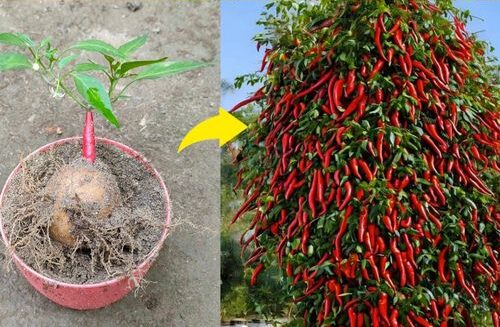Growing chili peppers at home for a continuous supply is rewarding and relatively easy. Here’s how you can do it:
1. Choosing the Right Varieties
- Selection: Choose chili varieties that suit your climate and culinary needs. Some popular varieties include jalapeños, habaneros, cayenne, and bird’s eye chilies.
- Indoor vs. Outdoor: If you plan to grow them indoors, opt for smaller varieties like Thai or dwarf chilies.
2. Starting Seeds
- Timing: Start seeds indoors 8-10 weeks before the last frost date if you’re planting outdoors.
- Soil: Use a seed-starting mix. Plant seeds ¼ inch deep in small pots or seed trays.
- Light: Keep them under grow lights or in a sunny window. Chilis need 14-16 hours of light daily for optimal growth.
- Temperature: Keep the temperature between 70-85°F (21-29°C) for germination.
3. Transplanting
- Timing: Transplant seedlings when they are about 6-8 weeks old and have at least 2-3 sets of true leaves.
- Outdoor Planting: If growing outdoors, wait until the soil has warmed and all danger of frost has passed.
- Spacing: Space plants about 18-24 inches apart in a sunny spot with well-drained soil.
4. Care and Maintenance
- Watering: Keep the soil consistently moist but not waterlogged. Water the base of the plants to avoid wetting the foliage.
- Feeding: Fertilize every 2-4 weeks with a balanced fertilizer or compost tea.
- Mulching: Apply mulch around the plants to retain moisture and suppress weeds.
- Pruning: Prune the plants to remove dead or damaged branches and to promote better air circulation.
5. Pollination (for Indoor Plants)
- Hand Pollination: If growing indoors, gently shake the plants or use a small brush to transfer pollen between flowers.
6. Harvesting
- Timing: Harvest chilies when they reach the desired color. Frequent harvesting encourages more fruit production.
- Storing: Store fresh chilies in a cool, dry place. You can also dry, freeze, or pickle them for long-term storage.
7. Continuous Supply
- Staggered Planting: Plant seeds every 2-4 weeks to ensure a continuous harvest.
- Overwintering: In colder climates, bring pots indoors before the first frost to overwinter your plants, so they produce again next year.
- Propagation: You can propagate from cuttings to create new plants from existing ones.
By following these steps, you can enjoy a steady supply of homegrown chili peppers all year round!

